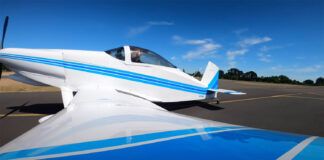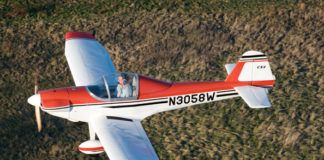Charging up Pikes Peak on a 258-horsepower electric motorcycle gets you in the record books and gives you a bit of a daredevil image. Chip Yates has the records and the image, but he says he takes calculated risks, not foolhardy ones. When I asked if he’d considered wearing a parachute on his Pikes Peak Hill Climb ride, he laughingly admitted that the thought had crossed his mind. The 12.42-mile, 156-turn course has plenty of gravel road and easy exits off precipitous edges at every turn.
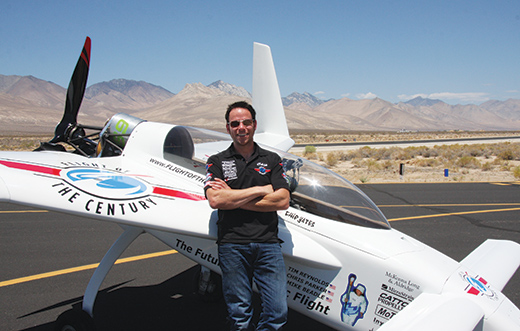
Chip Yates relaxes in front of the Long-ESA at Inyokern Airport in California.
Yates set more high marks, making it into the Guinness Book of World Records with a “flying kilometer” of 196.912 mph on his SWIGZ electric superbike at the Bonneville Salt Flats. The next day he briefly exceeded 201 mph on his way to achieving four American Motorcycle Association world records at flying-mile average speeds of 173.574, 181.439, 187.142 and 196.42 mph. He also garnered eight FIM (Federation Internationale de Motorcyclisme) records for 1 kilometer (0.62 miles) and 1 mile with a flying start. Each AMA and FIM world record required Yates to quickly recharge the battery pack and perform a repeat run in the opposite direction within 2 hours of the initial run to remove any possible tailwind advantage.
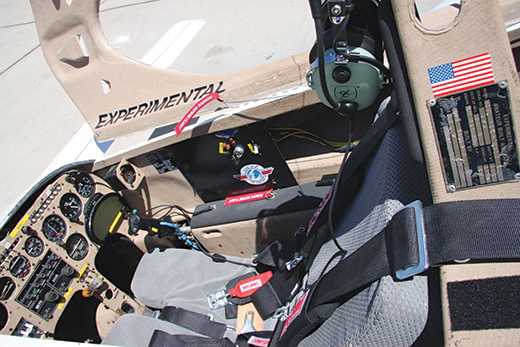
The cockpit of Yates’s Long-ESA doesn’t look all that different from the standard, but it is customized for his particular mission.
These records were not without their hazards. One flying mile saw the motorcycle’s drive chain disintegrate at 170 mph, accelerating bits of link shrapnel across the salt but decelerating Yates’s motorcycle instantly and sending it off track. On another run, he ran afoul of a marker at 150 mph, tearing up part of the bike, including its kinetic energy recovery system (KERS), a Yates exclusive that recharges the bike’s batteries from front-wheel braking energy.
Worse, Pikes Peak and the Salt Flats took their toll on batteries. Having run 428 volts and 600 amps on the Hill Climb, Yates found that his $40,000 battery pack “sagged” following the torturous beating it took, mainly from impedance buildup. He upgraded the motor controller firmware and increased the total system voltage to 453 volts by adding a small booster pack for Bonneville to help combat voltage sag. At Bonneville, the batteries were preheated to 100° to fight the loss of battery strength by reducing internal impedance. He had anticipated hitting 220 to 225 mph, but sag dropped pack potency to 300 volts, providing only 180 hp and holding him to a mere 200 mph.
Following a winning season, Yates donated the SWIGZ superbike to the Peterson Automotive Museum in Los Angeles but came back to retrieve one important part for his next adventure.
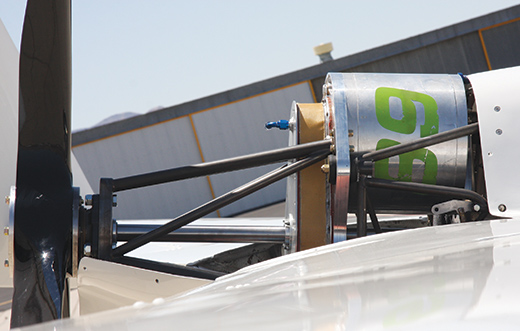
The 258-hp UQM motor used on Yates’s road-racing bike has gone over 200 mph on the Bonneville Salt Flats and conquered Pikes Peak.
One of the Best Days of His Life
“Yesterday [June 5] was one of best days of my life,” Yates said. Scaled Composites had heard of Yates’s electric aircraft programs and invited him and his team to speak to 50 engineers at headquarters in Mojave, California. A student pilot, Yates acted as pilot in command in his instructor’s twin Cessna 340, made a beautiful landing and gave an hour-long presentation to the Scaled team on his prospective electrically powered, transatlantic Charles Lindbergh flight. All were enthusiastic, and Dick Rutan and Mike Melville volunteered as test pilots. Despite the project’s amazing details, no one saw any major flaws or improbabilities in the plan.
A Plan to Rival Lindbergh’s
The planned route will follow Lindbergh’s epic 1927 flight, which accelerated aeronautical progress and inflamed popular enthusiasm. That single act by a brave pilot, adored by the public, tripled applications for pilot’s licenses in the U.S. and helped bring about a 400% increase in licensed aircraft. It also made it fashionable to travel by air, with paying airline passengers growing from 5782 in 1926 to 173,405 in 1929. Perhaps Yates’s flight will electrify the current aviation world in a similar way.
He will fly an all-electric airplane of his own design at an average speed higher than Lindbergh’s and will also keep the altitude below 10,000 feet to avoid taking advantage of jet streams that Lindbergh would not have encountered.
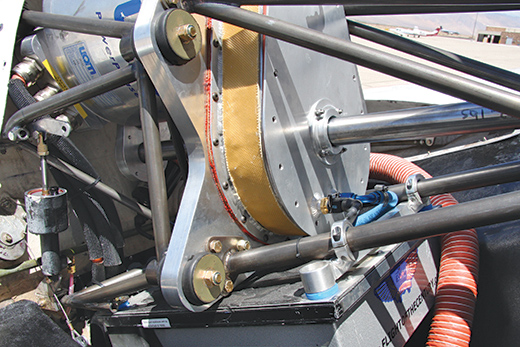
The custom-machined PSRU reduces prop speed and lowers thrust line. Note the Kevlar scatter shield, which prevents loose pieces from striking outboard tip rudders.
Warming up for the Main Event
Yates started R&D for the electric Lindbergh flight with a Rutan Long-EZ, removing its internal-combustion engine and replacing it with a modified version of the electric motor from his superbike. The airplane becomes the Long-ESA (Electric Speed and Altitude), going after high marks in those categories and possible world records.
Lindbergh had the latest in engine technology, a Wright Whirlwind J-5C putting out 223 hp and fueled by 450 gallons of aviation gas, weighing about 2700 pounds. As with all fuel-burning aircraft, the Spirit of St. Louis got lighter as it flew by burning off its fuel. Yates considered this a problem for his design team, composed of aeronautical engineers and energy experts, to contemplate. Battery-powered aircraft weigh the same on landing as they do on takeoff, but what if a pilot could jettison batteries or even swap battery packs mid-flight?
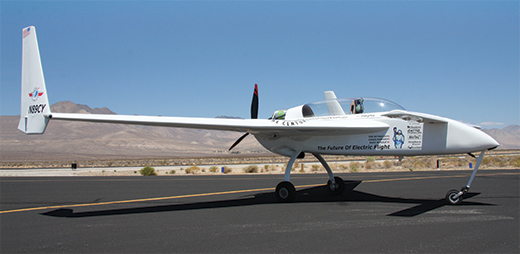
Yates and his Long-ESA captured a world speed record for electric aircraft on July 19 by breaking the 200-mph barrier. Record speed and altitude attempts continue.
For the Long-ESA test aircraft, Yates’s engineers calculated that an electric airplane, with, say, 10 small battery packs rather than one large, monolithic one, could gain a 92%-greater range by dropping off each battery pack as it ran down, lightening the airplane in transit.
To let battery packs down easy, his team came up with GPS-guided parachute or drone-type mini-UAV (unmanned aerial vehicle) configurations to be expelled when they reach a low-charge point. Spent battery packs would be guided to a specified touchdown point. Battery packs will be ejected from a pod beneath the aircraft, allowing them to clear the rear-mounted propeller.
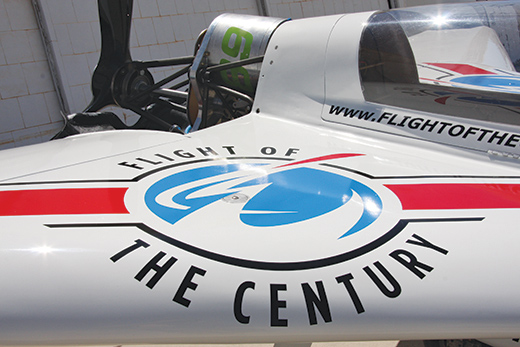
The motor and PSRU neatly replace the original Lycoming internal-combustion engine.
As a final protection for pilot and plane, the entire airframe will have a BRS recovery parachute, supplied by BRS founder and Lindbergh Foundation President and CEO Larry Williams.
To extend the range even farther, altitude attempts will allow testing of an aircraft KERS, taking the Long-ESA to high altitude and recovering energy from the windmilling prop on the way down, charging the airplane’s batteries rather than just producing drag.
Taxi tests started in July at the team’s flight-test headquarters at Inyokern Airport, with first flights to be performed in China Lake Naval Air Weapons Station’s restricted airspace, on invitation from open-minded scientists who want to study the flight characteristics of the all-electric aircraft. Besides the novel battery ejection, the airplane will serve as a test bed for the station’s UAV battery-pack tethering and docking technology, as well as its Jettison & Balance (JBS) battery-pack shuttling technology and software development, according to the Flight of the Century’s web site.
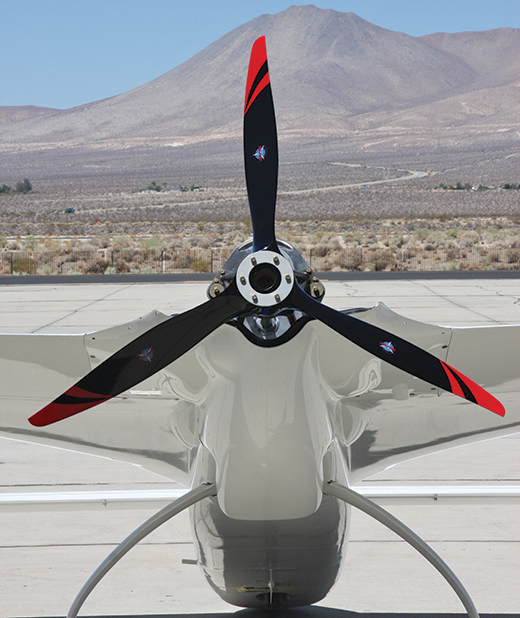
The Catto propeller, specially designed for the ESA, and a lack of exhaust pipes highlight the tail end of Yates’s airplane.
A former Space X engineer is working on the tethering and docking system, and the project is partnering with two battery companies to create the best systems for every aspect of the flight. As Yates noted, better batteries mean lighter weight, longer range, and, for the Atlantic hop, fewer recharging events.
Once Yates and his group have tried for the world’s records and learned what they can from range-extending strategies on the Long-ESA, they will then turn their attention to developing and building their own custom, more-than-100-foot wingspan, carbon-fiber, electric mothership, which will make it across the Atlantic using flying unmanned aerial vehicle (UAV) battery packs to recharge the manned aircraft midair.
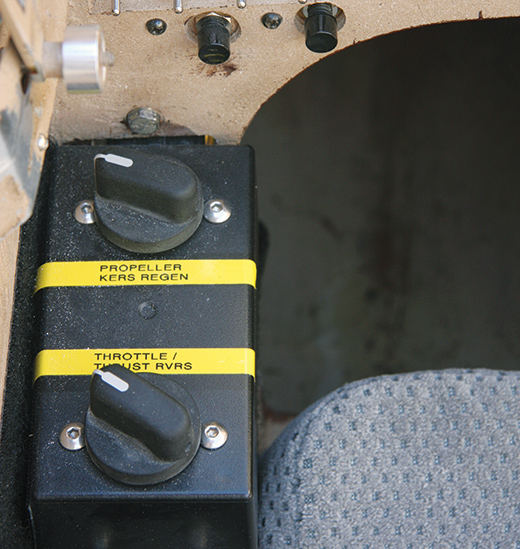
The KERS knob sends a command to regenerate electricity from the spinning prop, as during a descent. It can be used as a backup throttle. The thrust reverse switch reverses prop direction and allows throttle control of speed. Above that, the first three of the four breakers control the ECU, with the fourth controlling the high-voltage switching for the 450-volt battery pack. The lower four toggles control the MoTeC ECU.
Following Lindbergh
Yates’s transatlantic flight is enabled by FOTC’s battery-pack inflight recharging technology, which the company describes as a “mechanical solution to a chemical problem.” It will be a first instance of his concept of the “legitimate use of current tech to fly real-world missions.” He’s disappointed with the state of battery development but sees that as no reason to hold up progress.
The superbike’s $40,000 battery pack was “cutting edge,” with 108 pouch cells constraining 453.6 volts and able to hold up under 600-amp current draws—12.4 kilowatt hours in 230 pounds. Although that’s nearly three times the stored energy of a Prius, it pales compared to gasoline’s energy density of 12,000 watt-hours per kilogram. The SWIGZ bike’s cells held 86 times less energy per pound than gasoline.
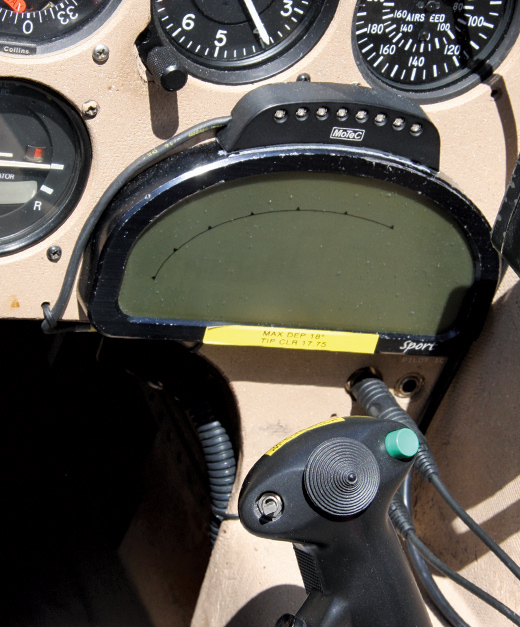
The MoTeC Sport Dash Logger acts as a display for the electronic control unit mounted near the canard. The ECU collects and logs data from 150 channels, including the electronic pitot-static system and the MicroStrain Attitude Heading and Reference System (AHRS). It also provides feedback to the pilot and allows ground tracking and monitoring of the aircraft.
Yates explains the bonuses and disadvantages of the packs. “While they allowed us to captivate the world with our gasoline-bike-equaling performance demonstrations, we could only match the gassers for six to seven laps (12 with our patented front-wheel KERS) around a typical racetrack. The performance matching was great, the range was terrible, and this was a no-holds-barred $250,000 motorcycle built by aerospace engineers.”
The liquid-cooled UQM motor and controller gave 92.5% efficiency, barely warming the radiators. But Yates worried about the batteries and motor controller, two regular concerns in electric vehicles.
Finding the selection of available batteries to be too heavy, lacking in power or energy density, or extravagantly expensive, Yates decided on innovation. “We’re not waiting around for batteries to catch up with fossil fuels,” he said. “We’re working around the issue with a creative and exciting solution that is going to change the face of aviation by making it green and exciting…and soon!”
The Atlantic flight, planned for 2014, has a further enhancement: inflight battery-pack swapping by UAVs that will follow two possible “docking” methods. One would involve piggybacking onto the host airplane and providing power at up to five points in the journey. This patent-pending Infinite Range Electric Flight (IREF) “refueling” technique will require a dexterous touch to coordinate linkups and intense planning and coordination to pull off.
The second would use “soft tethering” to hook up a supply airplane with the mothership. Once a probe and drogue-type connection is made, the supply vehicle would drop below and behind Yate’s airplane, a strategy once proposed for refueling long-range commercial flights. In this case, electrons rather than fuel will flow between the two.
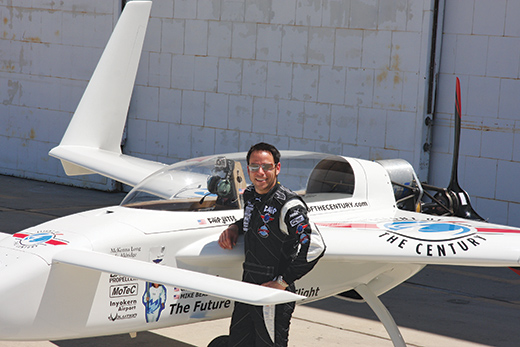
Full disclosure of Yates’s sponsors is readily apparent on the exterior of his Long-ESA.
The team is working on the logistics of the process, using NASA’s OTIS Trajectory Optimization Software for navigation and evaluating the benefits and disadvantages of carrying different-sized battery packs. Facing certification, aerodynamic and systems issues will probably stress the Yates team for the runup to their planned adventure. There are still many questions to be answered, which include the ingenious way in which UAVs will be launched to support the transatlantic attempt.
That will require careful planning and siting for places where drone aircraft can be launched to join the mothership and may also require ocean platforms for takeoffs and retrievals. In any of the scenarios, only one airplane will be piloted; the others will be autonomous vehicles using available technology to find and hook up with the transatlantic cruiser.
A successful crossing would show, along with the grand adventures of aircraft such as Solar Impulse, that formerly unthinkable aspirations are practical and could be applied to real-world needs.
Yates foresees an infrastructure mission for his autonomous payload carriers. A parcel delivery service with routes first between Los Angeles and San Francisco as a demonstration would fly light, high-value products to destinations and eventually spread out across the nation, even the world. Until energy storage becomes more in line with hoped-for specifications, the drones could fly collection and recharge missions to support carrier aircraft.
All this suggests an intelligence and willingness to face the unknown, along with a careful evaluation of the risks involved, an approach Lindbergh would probably be able to relate to.
Yates maintains that EVs are great when used properly. The bad outcomes result from the rush to production. Because FOTC is a record-seeking attempt with technological and logistics problems to overcome, it may be a milestone for others willing to explore the future of electric flight. If it succeeds, it could accelerate progress in this new field of aviation.

![]()
Dean Sigler has been a technical writer for 30 years, with a liberal arts background and a Master’s degree in education. He writes the CAFE Foundation blog and has spoken at the last two Electric Aircraft Symposia and at two Experimental Soaring Association workshops. Part of the Perlan Project, he is a private pilot, and hopes to get a sailplane rating soon.

